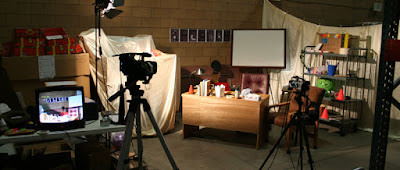This is a picture of one of our sets with both cameras set up:

Sure, this is a far cry from the 26 cameras that Howard Hughes used for "Hells Angels", but it's a step in that direction. I've never used two cameras to shoot a scene before and was truly unsure as to what it would be like and if it would help or not.
Since MathTacular4 is such a huge project that we have to complete in such a limited timeframe, we were able to procure another Canon GL2
So our current strategy, which we figured out as we went today, is as follows:
1. Shoot the scene with one camera (Camera A) Wide so we can see the whole scene and all the action and the other camera (Camera B) on a CU (Close-Up) on one of the actors.
2. Switch so Camera A is now on a CU and Camera B is on a Two-Shot of both actors.
3. Move on to the next part of the scene instead of running through the whole script and then going back through with the second setup. This is how we were doing it initially, but it makes way more sense to do it a segment at a time. That way, if you have to stop, you just start up with the next part of the scene rather than having to try to match your settings exactly to the day before.
It's pretty awesome. However, it is hardly perfect.
Since we are using two Lapel Microphones and nothing else, I'm only getting good audio into one of the cameras. This means that I'm going to have to figure out how I want to sync the audio for editing. This could make this whole deal a nightmare on that end. However, I'm pretty sure I can figure out a good way to approach this problem, and if I can keep my brain engaged while I capture the media, I should be fine.
The other big problem is that, in attempted to keep the two video files fairly in sync, I have to start and stop the cameras at almost exactly the same time. This is a level of stress that I would rather not deal with, but I'm not shooting on cameras that are expensive enough to allow for timecode syncing through Genlock.
Hopefully this additional camera will make the final product not only executable but also increase the overall quality of the video. Only time will tell, but it was a very exciting (albeit long) first day of multicam shooting.
~Luke Holzmann
Your Media Production Mentor

No comments :
Post a Comment